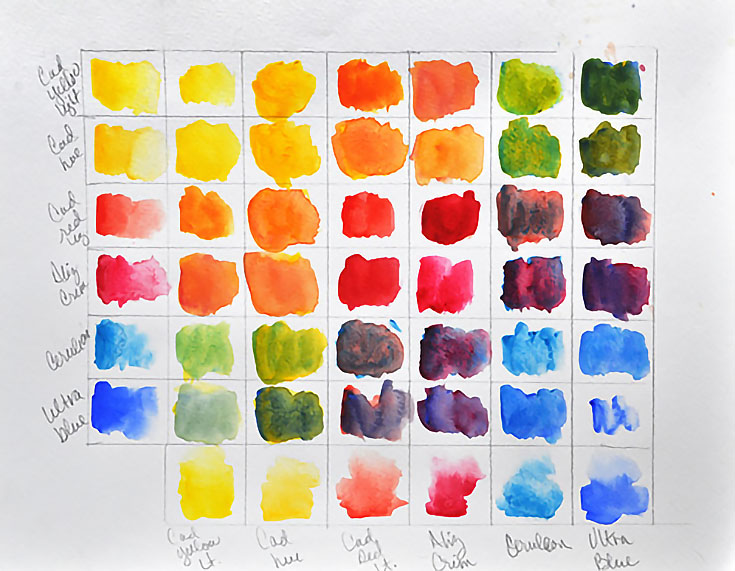Understanding color when painting may feel like confusing subject, but it really doesn’t need to be. By using just a limited number of colors, and learning how they behave when they are mixed together, you can learn everything you need to know!
I like to paint with a split primary palette, myself, but there are as many ideas about the perfect choice of colors as there are artists who use them. The important thing is to experiment with your colors, make a few charts and a color wheel, and take the mystery out of whatever palette of colors you choose!
Let’s start with a color wheel
A color wheel is one of the best learning tools available to the artist. You can get a store-bought color wheel and see (in general) how the colors go around the wheel, and how to mix them. But by making your own color wheel, you’ll learn the mixes and interactions that are specific to the colors of paint you own and use most often.
In the illustration above, you can see the color wheel that I created with a limited palette of six colors. I started my wheel by placing warm and cool primary colors at approximately 12 o’clock, 4 o’clock, and 8 o’clock. I then filled in the rest of the wheel by mixing the primaries with each other.
The end result gives me 15 colors total. Between cool yellow and cool blue, I have a greenish-yellow, a green, and a greenish-blue (the green family of colors). From my warm to my cool red, I have the violet colors, and from warm red to warm yellow, I have the orange family of colors.
As you can see, one of the benefits of using a simple, limited palette is that it’s easy to mix bright, clear, secondary colors. Once you’ve got your color wheel filled out (using your own paint colors) you’ll have a quick reference for most of the colors you will need to mix while painting!
Creating a color chart
Moving beyond a simple color wheel, creating a color chart is a great way to learn how to mix the secondary and tertiary colors. The chart I use (shown below) helps me see, and teach, the divisions that make up these additional colors.
To make your own color chart, lay out all of your colors that you use. Paint a small square of each color going down the left side of your paper, and then do the same thing again along the bottom of your paper (you may want to use a ruler and pencil to create a gride, beforehand.)
Then, fill in each of the squares of your grid by mixing the color on the left side with the color in the bottom row. The resulting hue will tell you a LOT about how your specific colors mix—and what colors you can achieve with your limited palette.
While this may seem like a lot of work and a waste of time, my experience has shown it to be of great value to students learning watercolor for the first time as well as those who are having trouble with color in their paintings.
NOTE: See how the mixed colors are a little “splotchy” or “uneven” in my chart? This is because I mixed the color directly on the paper. You may want to make several color charts—one chart could show how the colors look when mixed on the paper, another could show how the colors look when mixed on the palette. I’ve also done charts where I used more water (for lighter colors) and charts with less water (for darker colors).
Your charts will help you see which colors don’t work together, and should keep you from learning that lesson for the first time in the middle of an important painting! There are times when you need a muted color and times you want bold, clean, vibrant color. With your reference charts you will be able to see right away what color you want, and how to get it.
In time, you may find, as I did, that having too many color choices from the tube complicated the painting process. While I do keep a few other colors besides the ones above, I found that as long as I have the essential colors for my color wheel, and make a thorough chart, I can paint any color I need.
Now, go make those charts for yourself! You can’t beat them for a great reference when painting!
This post may contain affiliate links.


